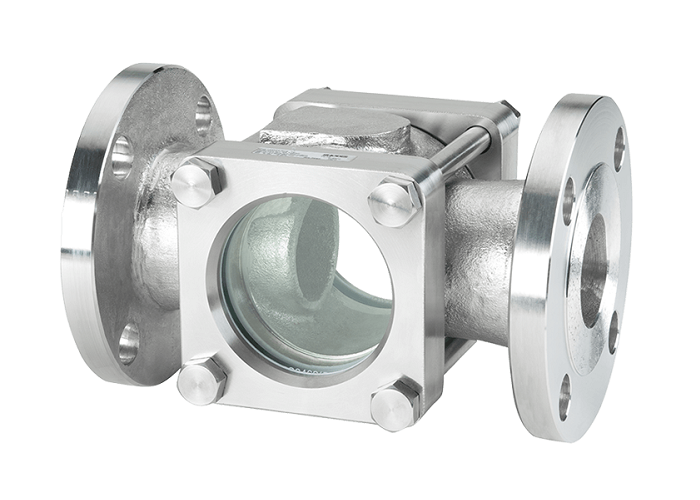
WHAT IS A SIGHT GLASS?
We use sight glasses to measure liquid levels. This device continuously indicates the level of liquid within a tank or vessel. To monitor a tank using the sight glass method, a transparent tube is attached to its bottom and top. By wearing visual goggles, plant operators can visually check the steps of a manufacturing process, monitor changes in media or fluids, and observe liquid levels.
ADVANTAGES
- Direct reading is possible.
- There are unique device designs available for use up to 3000°C and 650 kg/cmˆ2.
- Non-glass models are available in a variety of materials for corrosion resistance.
DISADVANTAGES
- The main disadvantage of using gauge glass is that it is not very easy to read the position of the fuel tank. Because the fuel tank sits at a distance, we can’t see it obviously.
- As the level gauge locates outside the reservoir, the liquid in the glass may freeze in cold or extreme weather. Even if the liquid inside the reservoir does not freeze, this may cause errors in the reading.
- Heavy, viscous liquids or liquids containing material that falls out of the solution and clogs the tube cannot be measured satisfactorily by this device.
- For long-level spans, we need overlapping gauges.
- Finally, the accuracy and readability of the glass reading depend on the cleanliness of the glass and fluid.
MATERIALS USED FOR SIGHT GLASSES
- Carbon and stainless steel. Stainless steel offers better corrosion resistance and is suitable for pharmaceutical applications.
- The standard gasket for most industrial applications consists of reinforced PF material or Teflon. Seal integrity is critical to successful indicator light performance.
- The standard gasket for most industrial applications consists of reinforced PF material or Teflon. For temperatures between 300◦ – 500◦ F, borosilicate generally is used. Quartz or sapphire glass is recommended for temperatures greater than 500◦ F, such as in high-temperature steam applications.
2 DISTINCT STYLES OF SIGHT GLASSES
- SIGHT GLASS WINDOW. It allows the operator to inspect process media, observe reactions, verify the presence or absence of media, and see the liquid level inside a process vessel or tank. Metal, glass, gaskets, and the body comprise its main components.
- SIGHT FLOW INDICATOR. Process piping uses visual flow indicators to monitor liquid or gas flow. By keeping the medium’s color, clarity, and flow through the window, operators can easily maintain the medium’s consistency. A pipeline indicator consists of a body with one or more viewing windows, gaskets, and a mounting method.
TYPES OF SIGHT GLASS WINDOW
- Glass discs are sandwiched between gasket metal rings in a window sight assembly. Cleaning is easy with this sight glass, which is suitable for non-critical processes and low pressures.
- A fused sight glass instrument is the industry standard for high-performance applications. The window and metal carrier ring are fused together during this type of sight glass construction.
TYPES OF SIGHT FLOW INDICATORS
- 360° VIEW FLOW INDICATOR. Fluid passes through a glass cylinder known as a full view flow indicator, which can be seen from all angles. The flow can be illuminated by ample ambient light. It helps observe the clarity, color, foam, and other characteristics of process fluids and moisture concentration. A high temperature or high pressure is not recommended for this product.
- VIEW THROUGH FLOW INDICATOR. This type is supplied with a single or two glasses on opposite sides, allowing the operator to see through ambient light or an attached luminaire through the process medium. This design is designed for ANSI pressure ratings, high temperatures and harsh fluid applications.
- FLAPPER FLOW INDICATOR. It may fit this with a hinged flapper visible through the signal site. The baffle is deviated in the direction of flow.The extent of deflection indicates the flow rate. Suitable for horizontal and vertical installations. Ideal for transparent fluids or gases which are hard to detect and for dark liquids which are challenging to observe.
- DRIP INDICATOR. They are designed for drip observation or conventional flow indicators installed with a drip tube. Drips and low-volume intermittent flows may be observed in applications such as distillation and are typically applied in vertical pipes with a downward flow.
- ROTARY FLOW INDICATOR. Flow indicators may be fitted with rotors or impellers turned by the flow of liquid or gas. The rotors are mounted within sight of the window so operators can observe the direction and approximate speed of the flow. It is particularly useful for transparent gases and fluids, though the rotor is also visible with dark fluids.
Manufacturers and operators can choose from various sight glasses in varying sizes and shapes. Visit our website at www.bcstgroup.com for more information about sight glasses and other liquid level indicating devices.






